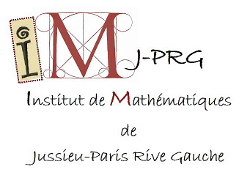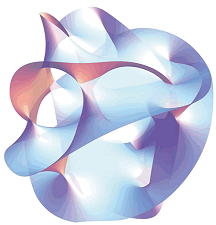Mini-courses :
Lucia Caporaso
From quantum cohomology to moduli of spin curves
The first lecture will describe some "classical" applications of Gromov-Witten theory and quantum cohomology to enumerative geometry, among which Kontsevich's recursive formula for rational plane curves of given degree.
The second will discuss some more recent progress about moduli spaces of curves and spin curves, with emphasis on ideas and techniques inspired by Gromov-Witten theory. The two lectures will be logically independent.
Chiu-Chu Melissa Liu
Open-closed mirror symmetry and topological recursion
The Remodeling Conjecture proposed by Bouchard-Klemm-Mariño-Pasquetti (BKMP) relates all genus open and closed Gromov-Witten invariants of a symplectic toric Calabi-Yau 3-manifold/orbifold to the invariants of its mirror curve defined by the Chekhov-Eynard-Orantin topological recursion. It can be viewed as an all genus open-closed mirror symmetry. In this mini-course, I will define these invariants and present a proof of the BKMP Remodeling Conjecture based on joint work with Bohan Fang and Zhengyu Zong.
Tony Pantev
Geometries arising from quantum invariants
I will explain how Gromov-Witten invariants introduce derived and non-commutative corrections to the geometry of moduli spaces of branes. The emphasis will be on understanding how these new geometries are transformed under non-trivial geometric dualities such as homological mirror symmetry or extremal transitions. I will discuss the associated Hodge theoretic invariants, and implications for the geometry of moduli of objects in Fukaya categories. If time permits I will explain a proposal for a new construction of a strong class of birational invariants of smooth projective varieties arising from categorified Gromov-Witten invariants. This is a joint work with L. Katzarkov and M. Kontsevich.
Tony Yue Yu
The Frobenius structure conjecture
The Frobenius structure conjecture is a conjecture about the geometry of rational curves in log Calabi-Yau varieties proposed by Gross-Hacking-Keel. It was motivated by the study of mirror symmetry. It predicts that the enumeration of rational curves in a log Calabi-Yau variety gives rise naturally to a Frobenius algebra, which is expected to be the mirror algebra. I will introduce the conjecture in the mini-course, and then explain how to use non-archimedean geometry to tackle the conjecture. We will study various properties of the moduli spaces of non-archimedean curves inside log Calabi-Yau varieties. I will also introduce a new notion of skeletal curve which plays a central role in the theory. If time permits, I will talk about the wall-crossing formula and comparison theorems for cluster algebras. It is based on my joint work with S. Keel.
Dimitri Zvonkine
Cohomological field theories
1. Definition and examples of CohFTs
Cohomological field theories are families of cohomology classes on moduli spaces of curves. They were introduced by Kontsevich and Manin to axiomatize properties of Gromov-Witten invariants. Since then many examples unrelated to these invariants were discovered.
2. Givental's group action
A large group, called the twisted symplectic group, acts on CohFTs. It allows one to construct more complicated CohFTs from simpler ones.
3. Applications.
Depending on time and the audience's wishes we can discuss tautological relations, the localization formula or Teleman's classification of semisimple CohFTs.
Research talks :
Pierrick Bousseau
A proof of Takahashi’s conjecture
I will present a proof of Takahashi’s conjecture on the multiple cover structure of Gromov-Witten theory of P^2 relative to a smooth cubic. This proof uses a mix of tropical and sheaf-theoretic techniques. In particular, it relies on the a priori unrelated study of the wall-crossing behavior of Donaldson-Thomas invariants of local P^2 upon variation of Bridgeland stability condition.
Tom Coates
Quantisation Formalism and Modularity for Gromov--Witten Potentials
I will describe a geometrised version of Givental's quantisation formalism for Gromov--Witten invariants and explain how, when combined with mirror symmetry, this allows us to prove that certain generating functions for Gromov--Witten invariants of local P^2 are modular functions. This is joint work with Hiroshi Iritani.
Bohan Fang
Oscillatory integrals on the T-dual branes
For a compact smooth toric Fano variety I will describe the oscillatory integrals in its mirror Landau-Ginzburg model. In particular, the oscillatory integrals over the T-dual Lagrangian cycles are given by Gromov-Witten descendant invariants with Gamma classes inserted. This will lead to the Gamma II conjecture for toric Fano varieties, relating the asymptotic fundamental solutions of the quantum differential equations to an exceptional collection in the derived category. This talk is based on the work with Chiu-Chu Melissa Liu and Zhengyu Zong, and on the work with Peng Zhou.
Mark Gross
Intrinsic mirror symmetry
This is joint work with Bernd Siebert aiming to construct mirror pairs in complete generality, starting with either log Calabi-Yau manifolds (X,D) with maximally degenerate boundary or maximally unipotent degenerations of Calabi-Yau manifolds X->S. We construct the (homogeneous) coordinate ring of the mirror using a new type of logarithmic Gromov-Witten theory of (X,D) called punctured invariants, developed jointly with Abramovich, Chen and Siebert.
Jérémy Guéré
Hodge-Gromov-Witten theory via p-fields
In this talk, I will give a new approach to the computation of Hodge integrals for FJRW theory, yielding as a genus-zero example mirror symmetry for Landau--Ginzburg models. Then, I will introduce the moduli space of p-fields for hypersurfaces in weighted projective space and transfer the previous approach to this context. Eventually, I will discuss further directions involving more general GLSM models.
Felix Janda
Gromov-Witten theory of quintic threefolds via log GLSM
Quintic threefolds are one of the simplest families of compact Calabi-Yau threefolds, and hence are very interesting from the point of view of enumerative geometry and Gromov-Witten theory. In particular, physicists have predicted that the generating series of genus g Gromov-Witten invariants is "modular" in some sense. In my talk, I will describe a new technique called log GLSM (in development with Q. Chen and Y. Ruan) that can be used to prove the modularity and further predictions (joint with S. Guo and Y. Ruan).
Marc Levine
Welschinger invariants as quadratic degrees
This is a report on a joint work with Kass, Solomon and Wickelgren. We have defined a quadratic form on the unordered configuration space of a del Pezzo surface S whose degree gives the classical count of rational curves in a curve system |D| passing through -D.K_S-1 points and whose signature gives the Welschinger invariant at a given real configuration of points. We review this construction and give two interpretations of this form as the quadratic degree of the evaluation map from the moduli space of stable maps to the unordered configuration space, and show how this construction recovers and extends Welschinger’s theorem on the independence of his invariant among point configurations of the same real type in the case S=P^2.
Etienne Mann
Gromov-Witten invariants with derived algebraic geometry
In this talk, we will explain how derived algebraic geometry gives a generalization of cohomological field theory to "a geometric field theory". This is a joint work with Marco Robalo.
Grigory Mikhalkin
Canonical area for real curves and surfaces
Real K3-surfaces (as well as log K3-surfaces) have the well-defined (up to a scalar) area form coming from the holomorphic 2-form. In particular, this area can serve as a tool for refinement of the enumeration of rational curves. It turns out that there are inequalities constraining the area of different components of the K3 surface (a joint work in progress with Ilia Itenberg).
Johannes Nicaise
The non-archimedean SYZ fibration
This talk is based on joint work with Chenyang Xu and Tony Yue Yu. I will explain the construction of the non-archimedean Strominger-Yau-Zaslow fibration, whose existence was conjectured by Kontsevich and Soibelman in their non-archimedean approach to Mirror Symmetry. I will also explain why it is an affinoid torus fibration away from a codimension two subset of the base, as predicted by Kontsevich and Soibelman. The proof reveals some interesting interactions between Mirror Symmetry, non-archimedean geometry and the Minimal Model Program in birational geometry.
Mauro Porta
Non-archimedean quantum K-theory
In this talk, I will survey recent ongoing work in collaboration with Tony Yue Yu. Using derived analytic geometry we define and study the main properties of non-archimedean Gromov-Witten invariants at the level of K-theory. The use of derived geometry allows to recast the usual Kontsevich-Manin and Behrend-Manin axioms in a more geometrical form, and it also allows for more direct proofs. This approach allows us to avoid talking directly about virtual fundamental classes, which is advantageous in the analytic setting where global resolutions rarely exist.
Zhengyu Zong
Remodeling Conjecture and its applications
Based on the work of Eynard-Orantin and Marino, the Remodeling Conjecture was proposed in the papers of Bouchard-Klemm-Marino-Pasquetti in 2007 and 2008. The Remodeling Conjecture can be viewed as an all genus mirror symmetry for toric Calabi-Yau 3-orbifolds. It relates the higher genus open Gromov-Witten potential of a toric Calabi-Yau 3-orbifold to the higher genus B-model potential which is obtained by applying the topological recursion on the mirror curve. The Remodeling Conjecture has many nice applications. In this talk, I will first discuss the proof of the remodeling conjecture. Then I will discuss some of its applications such as the holomorphic anomaly equation, modularity, and the crepant resolution conjecture.
Posters :
David Kern
Towards wall-crossing for categorified quasimap CohFTs
Following Mann and Robalo's construction of categorified Gromov-Witten invariants, we sketch a categorification of quasimap invariants, which we interpret as a naturally stacky theory. In particular, the moduli stack of pre-stable curves is replaced by that of stacky (or twisted) curves, so that the resulting field theory is defined on a cyclotomic
loop stack of the target stack. Working on orbifolds also adds the possibility of parameterising the stability conditions by rational line bundles, giving rise to wall-crossing phenomena between the CohFTs associated with different chambers.
(pdf)
Mara Ungureanu
The geometry of secant varieties to algebraic curves
For a smooth, projective variety, the varieties parametrising its secant planes are among the most studied objects in classical enumerative geometry. In this poster we shall define secant varieties in the case of curves and study some unexpected properties of their geometry that arise as non-transversality of intersections inside the symmetric product of the curve.
(pdf)
Nina Morishige
Genus zero Gopakumar-Vafa invariants of the Banana manifold
The Banana manifold X is a compact Calabi-Yau threefold fibered by Abelian surfaces with a certain type of singular fiber. We compute Katz’s genus 0 Gopakumar-Vafa invariants of fiber curve classes on the Banana manifold. The weak Jacobi form of weight -2 and index 1 is the associated generat- ing function for these invariants. The genus 0 Gopakumar-Vafa invariants also turn out to be an actual count of structure sheaves of certain possibly nonreduced genus 0 curves on the universal cover of the singular fibers of X.
Giulio Orecchia
A log-tropical criterion for existence of Néron models
Over a base scheme of dimension greater than 1, an abelian scheme does not always admit a Néron model. I introduce a criterion for their existence, which, in the case of the jacobian of a curve, is strictly related to the representability of the Log and Tropical Picard functor.
(pdf)
Rachel Webb
Virtual Cycle on the Moduli Space of Maps to a Complete Intersection
A driving question in Gromov-Witten theory is to relate the invariants of a complete intersection to the invariants of the ambient variety. In genus-zero this can often be done with a ``twisted theory,'' but this fails in higher genus. Several years ago, Chang-Li presented the moduli space of p-fields as a solution to the higher-genus problem, constructing the virtual cycle on the space of maps to the quintic 3-fold as a cosection localized virtual cycle on a larger moduli space (the space of p-fields). Their result is analogous to the classical statement that the Euler class of a vector bundle is the class of the zero locus of a generic section. This poster presents work joint with Qile Chen and Felix Janda where we extend Chang-Li's result to a more general setting, a setting that includes standard Gromov-Witten theory of smooth projective targets and quasimap theory of GIT targets.



